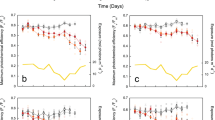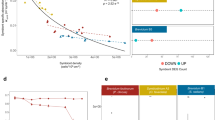Abstract
STUDY of incremental banding in coral skeletons was initiated by Ma1 and later extended by Wells2 and others3. More recently, discrete annual banding in the skeletons of certain hermatypic corals4,5,6 has been described. Here we present an analysis of annual band width measurements from Bermuda corals which relates, through regression techniques, coral band time series to air temperature and air pressure variations. Our results indicate that coral bands record important aspects of their environment and therefore become useful where reconstruction of palaeoclimatic variables is of interest. Specifically the coral time series may be used as a palaeotemperature indicator or, when coupled with relatively well established palaeotemperatures, for palaeobarometric pressure determinations. Derived series of otherwise unobtainable palaeovariables are important not only for work on coral physiology, but also for construction and testing of climatic models; in this later instance information on palaeopressure is particularly desirable.
This is a preview of subscription content, access via your institution
Access options
Subscribe to this journal
Receive 51 print issues and online access
$199.00 per year
only $3.90 per issue
Buy this article
- Purchase on SpringerLink
- Instant access to full article PDF
Prices may be subject to local taxes which are calculated during checkout
Similar content being viewed by others
References
Ma, T. Y. H., Palaeon. sin., XVI, Ser. B (1937).
Wells, J. W., Nature, 197, 948–950 (1963).
Scrutton, C. T., and Hipkin, R. G., Earth Sci. Rev., 9, 259–274 (1973).
Knutson, D. W., Buddemeier, R. W., and Smith, S. V., Science, 177, 270–272 (1972).
Dodge, R. E., and Thomson, J., Earth planet. Sci. Lett., 23, 313–322 (1974).
Macintyre, I. G., and Smith, S. V., Proc. Second Int. Symp. on Coral Reefs, 2, 277–287 (1974).
Fritts, H. C., Mosimann, J. E., and Bottorff, C. P., Tree-Ring Bull., 29, 15–20 (1969).
Macky, W. A., Bermuda Met. Off. Tech. Note No. 4, 48 (Bermuda Press, Hamilton, 1948); data for Bermuda from US Climate Center, Asheville, North Carolina, USA.
Macky, W. A., Bermuda Met. Off. Tech. Note No. 9, 16 (Bermuda Press, Hamilton, 1955).
Dodge, R. E., and Vaišnys, J. R., Geol. Soc. Am. Prog, with Abs., 7, 1055 (1975).
Weber, J. N., Deines, P., White, E. W., and Weber, P. H., Nature, 255, 697–698 (1975).
Fritts, H. C., Blasing, T. J., Hayden, B. P., and Kutzbach, J. E., J. appl. Met., 10, 845–864 (1971).
Clark, N. E., Blasing, T. J., and Fritts, H. C., Nature, 256, 302–305 (1975).
Mensel, D. W., and Ryther, J. H., Deep Sea Res., 7, 282–288 (1961).
Dansgaard, W., Johnsen, S. J., Reeh, N., Gundertrap, N., Clausen, H. B., and Hammer, C. U., Nature, 255, 24–28 (1975).
Scoffin, T. P., and Garrett, P., Proc. Second Int. Symp. on Coral Reefs, 2, 429–448 (1974).
Author information
Authors and Affiliations
Rights and permissions
About this article
Cite this article
DODGE, R., VAIŠNYS, J. Hermatypic coral growth banding as environmental recorder. Nature 258, 706–708 (1975). https://doi.org/10.1038/258706a0
Received:
Accepted:
Issue date:
DOI: https://doi.org/10.1038/258706a0
This article is cited by
-
Dissepiments, density bands and signatures of thermal stress in Porites skeletons
Coral Reefs (2017)
-
Spatial variation in porosity and skeletal element characteristics in apical tips of the branching coral Acropora pulchra (Brook 1891)
Coral Reefs (2011)
-
Coral skeletal carbon isotopes (δ13C and Δ14C) record the delivery of terrestrial carbon to the coastal waters of Puerto Rico
Coral Reefs (2011)
-
Growth characteristics of the reef-building coral Porites astreoides under different environmental conditions in the Western Atlantic
Coral Reefs (2010)



